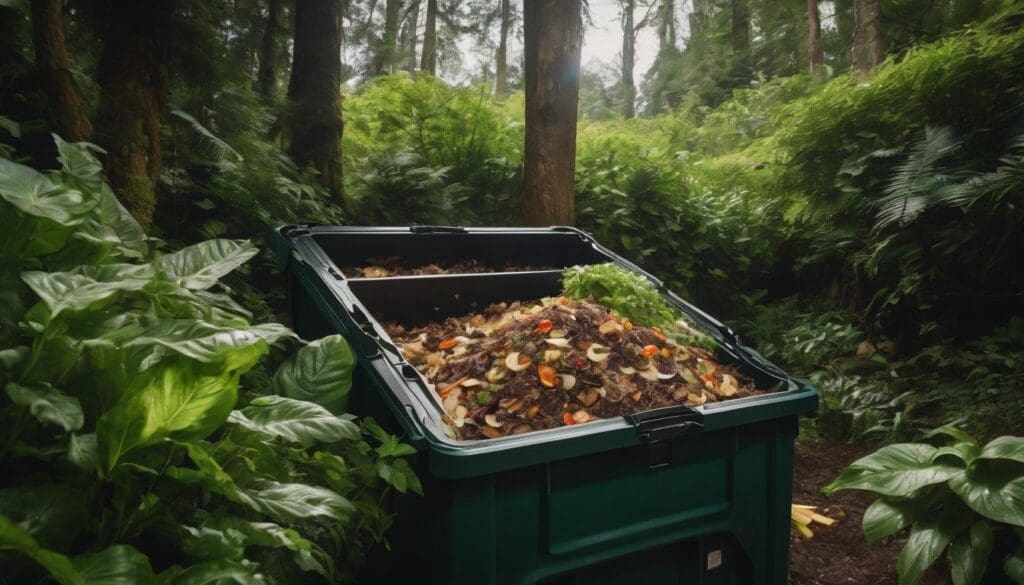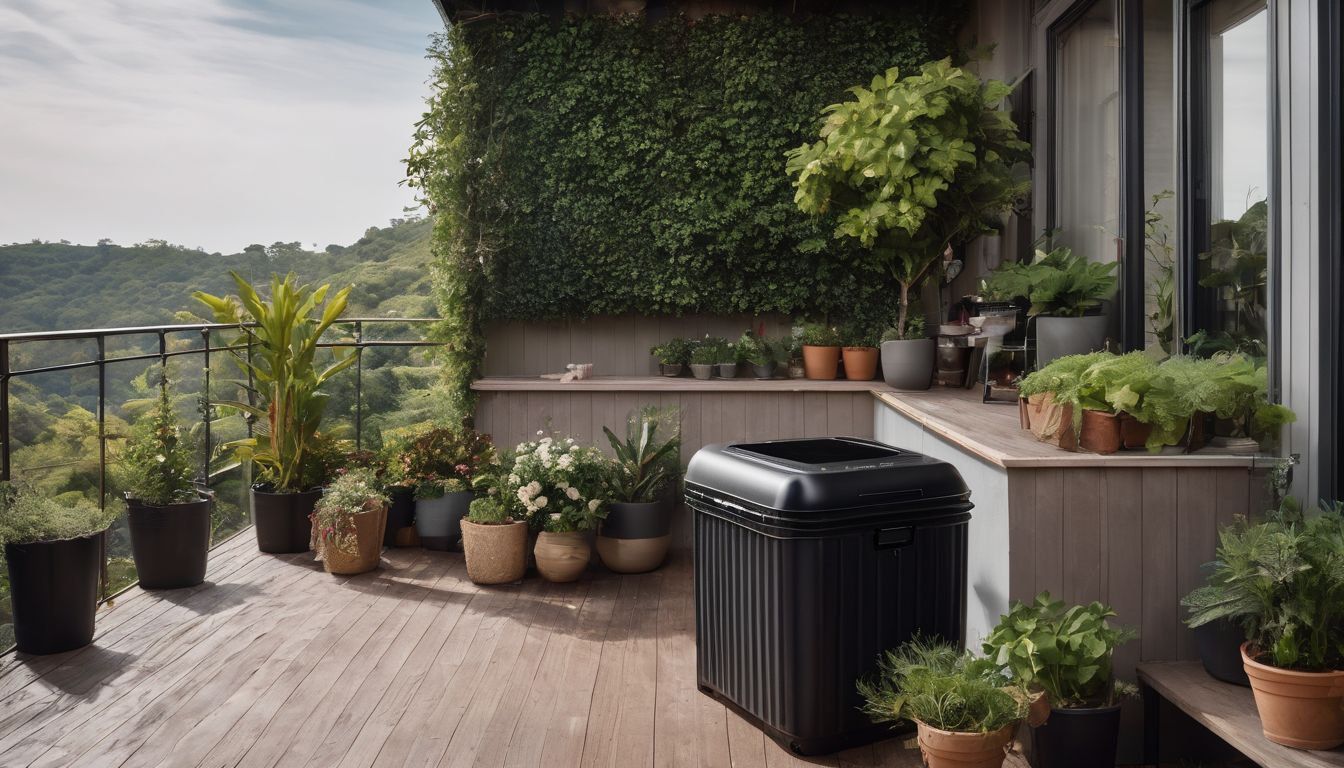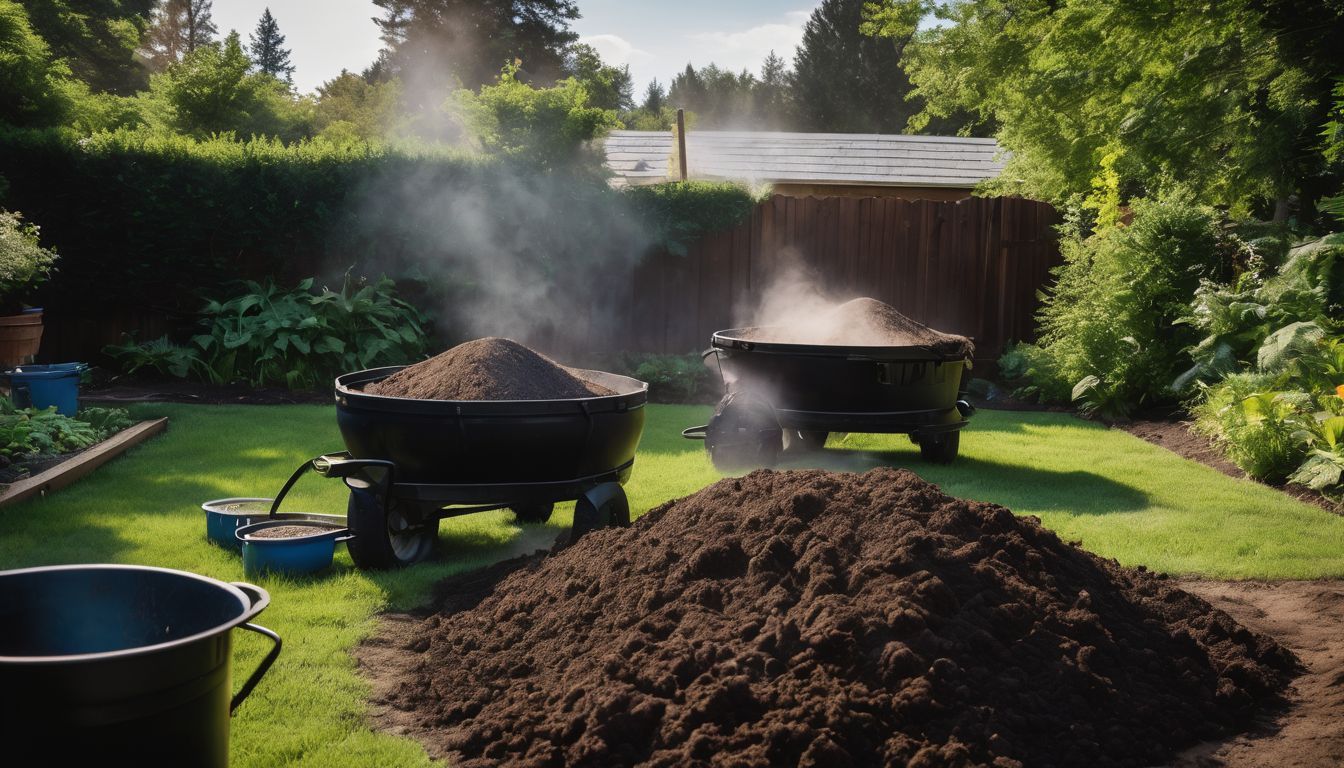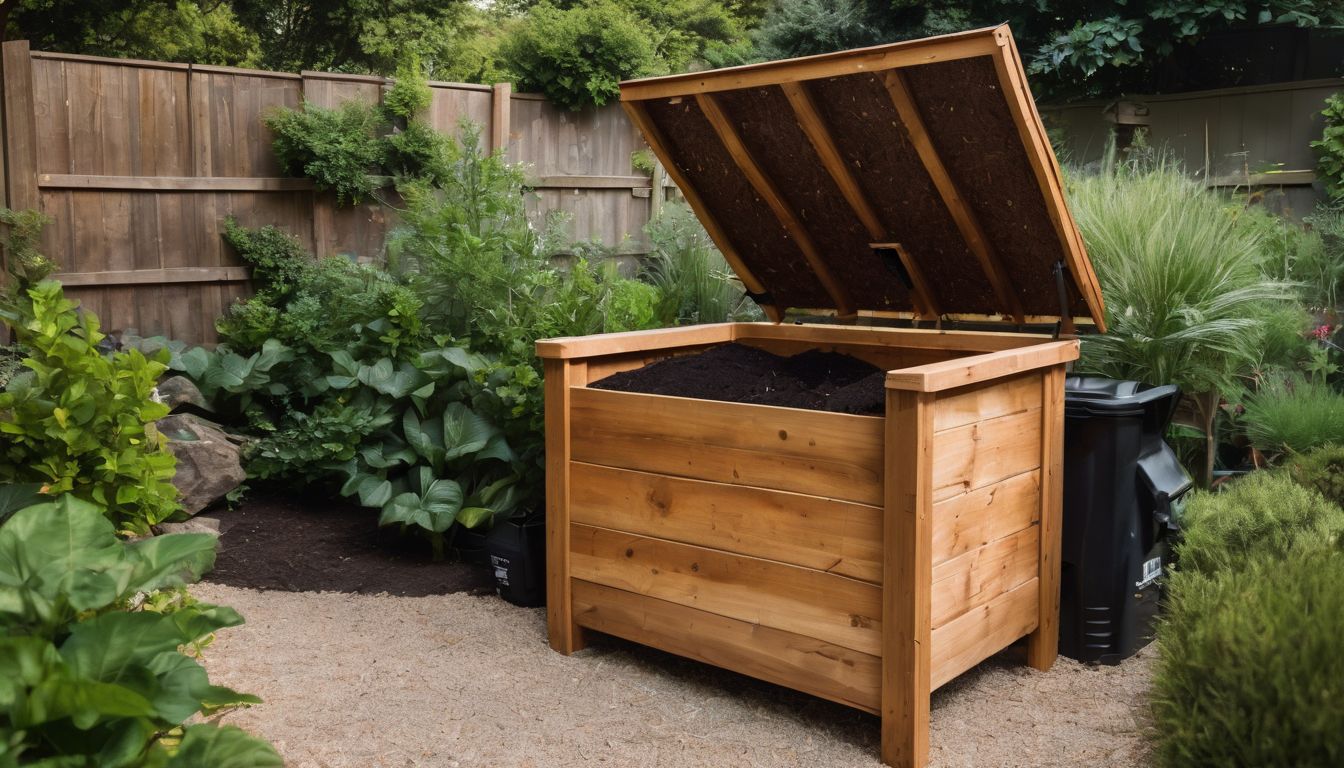Are you looking for a swift and efficient way to recycle your kitchen waste? Bokashi composting is an ancient Japanese technique that transforms food scraps into nutrient-rich soil conditioner.
This article will guide you through the simple steps of Bokashi composting, helping you turn waste into wonder. Dive in for a greener tomorrow!
Key Takeaways
- Bokashi composting is a quick method that ferments kitchen waste, including dairy and meat, in an air-tight container with bokashi bran.
- The process is eco – friendly, cutting down on greenhouse gases and landfill use while creating rich soil conditioner for gardens.
- It’s important to maintain the composter by ensuring it stays airtight, regulating moisture levels and draining excess liquid.
- Bokashi tea made from fermented compost can be used as a natural fertiliser to boost plant health.
- By integrating bokashi compost into garden soil, you improve soil fertility while participating in sustainable waste reduction practices.
What is Bokashi Composting?
Bokashi composting is a fermentation process that differs from traditional composting methods, allowing for the rapid breakdown of organic materials in an airtight container. This alternative method offers benefits such as the ability to compost dairy and meat scraps, making it a popular choice for environmentally conscious individuals.
The process of fermentation
The process of fermentation sits at the heart of Bokashi composting, turning kitchen waste into rich soil conditioner. Microorganisms thrive in an anaerobic environment, where they break down organic matter without oxygen.
These tiny life forms feast on your leftovers, including dairy and meat scraps which traditional composting methods often can’t handle. You’ll sprinkle a handful of bokashi bran onto each layer of scraps within an airtight container to kickstart this process.
Fermentation works its magic surprisingly fast compared to conventional composting. Within just two weeks, you’ll see that green waste transforms into something gardeners treasure: pre-compost.
This material can be buried directly in garden soil or added to your regular compost bin where it will continue to decompose aerobically and enrich the earth. By embracing this alternative method, you contribute to sustainable practices and significant waste reduction while enhancing your plant’s health with nutrient-dense soil amendments made right from your kitchen discards.
How it differs from traditional composting
Bokashi composting differs from traditional composting in its use of anaerobic fermentation, which occurs in an airtight container. Unlike traditional composting that relies on aerobic decomposition with oxygen, bokashi composting breaks down organic waste without oxygen.
This method can handle a wider variety of kitchen scraps, including meat and dairy products that are usually avoided in traditional compost heaps due to the risk of attracting pests and causing odours.
Additionally, the process takes place at a faster rate, producing nutrient-rich soil amendment within weeks rather than months.
The rapid breakdown of plant matter through anaerobic fermentation enables environmentally conscious individuals to manage organic waste more effectively while generating beneficial soil enrichment for gardening or farming activities.
Benefits of using this method
Using the Bokashi composting method offers several benefits. Firstly, it allows for the anaerobic decomposition of organic waste, including dairy and meat scraps, in an airtight container.
This means that kitchen waste management becomes more efficient and odour-free. Additionally, this alternative composting method reduces greenhouse gas emissions by fermenting organic materials instead of letting them break down aerobically in landfills.
Furthermore, the Bokashi inoculant application enriches the resulting compost with beneficial microbes that can enhance soil fertility when added to garden beds or used to make bokashi tea.
How to Bokashi Compost in 7 Steps
To start bokashi composting, choose a suitable composter and layer kitchen scraps with bokashi bran. Maintain the composter and troubleshoot any issues that may arise for successful fermentation composting.
Choosing a Bokashi composter
When choosing a Bokashi composter, look for an airtight container with a tap and drainage plate to avoid air exposure. Ensure the composter is made of durable, high-quality materials that can withstand the fermentation process without leaking or breaking.
Look for a design that allows for easy access to add kitchen scraps and bokashi bran, as well as efficient draining of excess liquid. Select a size suitable for your needs to efficiently ferment organic waste while maximising space.
Consider purchasing from reputable brands or suppliers that offer additional accessories such as bokashi bran and replacement parts. Compare different models based on their capacity, ease of use, and maintenance requirements to find one that fits seamlessly into your sustainable lifestyle.
Layering kitchen scraps and bokashi bran
When layering kitchen scraps and bokashi bran, first, place a thick layer of food waste in the Bokashi composter. Then, evenly distribute a handful of bokashi bran over the scraps.
Repeat this process for each additional layer of organic material until the composter is full. It’s important to press down on each layer to remove any air pockets and ensure that the entire mixture is compact.
The fermentation process begins as soon as the kitchen scraps and bokashi bran mix together. This method allows you to compost all types of organic waste, including dairy and meat products that cannot typically be composted with traditional methods.
Layering kitchen scraps with bokashi bran creates an ideal environment for beneficial microbes to break down organic matter aerobically while reducing odors and attracting fewer pests.
How to maintain and troubleshoot issues
After layering the kitchen scraps and bokashi bran, it’s important to know how to maintain and troubleshoot any issues that may arise during the bokashi composting process. Here are some key steps to help you keep your composting system running smoothly:
- Check for airtightness of the container regularly to ensure proper fermentation.
- If you notice any foul odours, check for leaks or cracks in the container and reseal if necessary.
- Monitor the moisture level of the compost – it should be damp but not soggy. Add more bokashi bran if it becomes too wet.
- Keep an eye out for mold growth – if mold appears, add extra bokashi bran and mix well to restore balance.
- In case of excessive liquid accumulation, drain off any excess bokashi tea to prevent anaerobic conditions.
- Stir the contents of the composter regularly to promote even fermentation and prevent clumping.
- If you encounter any issues with pests or flies, ensure that the container is properly sealed and consider adding a layer of newspaper over the top before closing.
Alternative Uses for Bokashi Compost
Besides using bokashi compost for traditional gardening, it can also be utilised to make bokashi tea and improve garden soil. Discover more alternative uses of bokashi compost by reading on.
Making bokashi tea
To make bokashi tea, simply mix bokashi compost with water in a sealed container and allow it to ferment for around two weeks. Once fermented, strain the liquid and dilute it to use as a powerful fertiliser for houseplants or garden soil.
Bokashi tea is rich in beneficial microbes that help break down organic matter and enhance soil health, making it an excellent natural alternative to chemical fertilisers.
Also, using this nutrient-rich liquid provides an effective way to further reduce waste while promoting sustainability and environmental conservation efforts. This method not only maximises the potential of organic waste but also supports healthier plant growth without any harmful impact on the environment.
Using in garden soil
After making bokashi tea, the next step is using the nutrient-rich bokashi compost in garden soil. Incorporating bokashi compost into your garden soil helps improve its structure and fertility.
The beneficial microorganisms present in the compost enhance the soil’s health by breaking down organic matter and supporting plant growth. Additionally, this method reduces food waste sent to landfills, contributing to a more sustainable environment.
To use in garden soil effectively, simply mix the bokashi compost directly into the earth or create a bokashi layering trench for effective decomposition of kitchen scraps and other organic waste materials.
The Basics of Bokashi Composting
Bokashi Composting uses a fermentation process to break down organic waste, creating a nutrient-rich soil amendment – learn more about this eco-friendly method and its benefits by reading the full blog.
Types of organic materials that can be used
Various organic materials can be used in bokashi composting, including fruit and vegetable scraps, coffee grounds, eggshells, bread, grains, and leftover cooked food. Dairy products and meat scraps can also be added to the mix.
Additionally, small amounts of paper and cardboard (such as shredded newspaper or tissue) can be included for added carbon content. These materials provide a rich source of nutrients for the fermentation process within the airtight container.
The breakdown of these organic materials by bokashi fermentation enriches the resulting soil with beneficial microorganisms that support plant growth. This method is particularly beneficial for individuals looking to reduce their environmental impact by diverting organic waste from landfills while simultaneously creating an enriched soil amendment for sustainable gardening practices.
How the process works
The Bokashi composting process works by utilising a mix of kitchen scraps and bokashi bran in an airtight container. The anaerobic fermentation that occurs within the container breaks down organic waste, including dairy and meat scraps, effectively.
This method differs from traditional composting as it can handle items not suitable for regular compost bins while also producing nutrient-rich soil amendments and liquid fertiliser known as bokashi tea.
By adding layers of food waste and sprinkling each layer with bokashi bran, the beneficial microbes present begin to ferment the material, ultimately creating a rich soil conditioner when buried or added to garden soil.
Conclusion
In conclusion, Bokashi composting provides a unique and efficient way to recycle kitchen waste. By fermenting organic materials in an airtight container, it offers environmental benefits and reduces landfill waste.
This alternative method is perfect for those interested in sustainable living. Consider giving it a try if you are looking for a convenient way to dispose of your organic waste responsibly.
FAQs
1. What is Bokashi composting?
Bokashi composting is a method of organic waste disposal where you ferment kitchen and garden scraps, including dairy and meat, in an airtight container with bokashi bran.
2. Can I put meat scraps in my Bokashi compost bin?
Yes, you can add meat and dairy scraps to your Bokashi bin. The airtight container composting process allows for these types of materials thanks to the bokashi inoculant fermentation.
3. How does adding bokashi bran help in composting?
Adding bokashi bran speeds up the fermentation process within the sealed container, breaking down your kitchen scraps into nutrient-rich material faster than traditional composting methods.
4. Are there environmental benefits to using the Bokashi method for composting?
Indeed, by recycling food waste through Bokashi Composting: An Alternative Method, you reduce landfill use and emissions from organic matter decomposition, offering significant environmental benefits.





